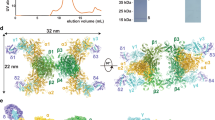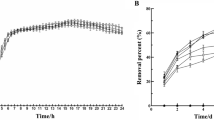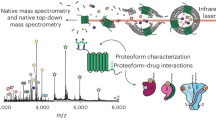Abstract
In vertebrate rod cells, the activated α-subunit of rod transducin interacts with the γ (regulatory) subunits of phosphodiesterase to disinhibit the catalytic subunits. A 22-amino acid long region of rod transducin involved in phosphodiesterase activation has recently been identified. We have used peptides from this region of rod transducin and from several other G protein α-subunits to study the nature and specificity of the G protein α-effector interaction. Although peptides derived from rod transducin, cone transducin and gustducin are similar, only the rod peptide is capable of activating rod phosphodiesterase. Using substituted peptides we have identified five residues on one exposed face of rod transducin as important to phosphodiesterase activation. These results disagree with previous models which propose that loop regions of rod transducin interact with phosphodiesterase γ
This is a preview of subscription content, access via your institution
Access options
Subscribe to this journal
Receive 12 print issues and online access
$259.00 per year
only $21.58 per issue
Buy this article
- Purchase on SpringerLink
- Instant access to full article PDF
Prices may be subject to local taxes which are calculated during checkout
Similar content being viewed by others
References
Conklin, B.R. & Bourne, H.R. Structural elements of Gα subunits that interact with Gβγ, receptors, and effectors. Cell 73, 631–641 (1993).
Lochrie, M.A. and Simon, M.I. G protein multiplicity in eukaryotic signal transduction systems. Biochemistry 27, 4957–4965 (1988).
Wilkie, T.M. et al. Evolution of the mammalian G protein α subunit multigene family. Nature Genet. 1, 85–91 (1992).
Dixon, R.A.F. et al. Cloning of the gene and cDNA for mammalian α-adrenergic receptor and homology with rhodopsin. Nature 321, 75–79 (1986).
Nathans, J. and Hogness, D.S. Isolation, sequence analysis, and intron-exon arrangement of the gene encoding bovine rhodopsin. Cell 34, 807–814 (1983).
Nathans, J., Thomas, D. & Hogness, D.S. Molecular genetics of human color vision: the gene encoding blue, green and red pigments. Science 232, 193–202 (1986).
Buck, L. & Axel, R. A novel multigene family may encode odorant receptors: A molecular basis for odor recognition. Cell 65, 175–187 (1991).
Birnbaumer, L. G proteins in signal transduction. A. Rev. Pharmacol. Toxicol. 30, 675–705 (1990).
Hamm, H.E., Deretic, D., Arendt, A., Hargrave, P.A., König, B. & Hofmann, K.P. Site of G protein binding to rhodopsin mapped with synthetic peptides from the α subunit. Science 241, 832–835 (1988).
Conklin, B.R., Farfel, Z., Lustig, K.D., Julius, D. & Bourne, H.R. Substitution of three amino acids switches receptor specificity of Gqα to that of Giα. Nature 363, 274–276 (1993).
Findlay, J.B.C. & Pappin, D.J.C. The opsin family of proteins. Biochem. J. 238, 625–642 (1985).
König, B., Arendt, A., McDowell, J.H., Kahlert, M., Hargrave, P.A. & Hofmann, K.P. Three cytoplasmic loops of rhodopsin interact with transducin. Proc. natn. Acad. Sci. U.S.A. 86, 6878–6882 (1989).
Rarick, H.M., Artemyev, N.O. & Hamm, H.E. A site on rod G protein α subunit that mediates effector activation. Science 256, 1031–1033 (1992).
Berlot, C.H. & Bourne, H.R. Identification of effector-activating residues of Gsα . Cell 68, 911–922 (1992).
Itoh, H. & Gilman, A.G. Expression & analysis of Gsα mutants with decreased ability to activate adenylycyclase. J. biol. Chem. 266, 10864–10871 (1991).
Stryer, L. Visual excitation and recovery. J. biol. Chem. 266, 10711–10714 (1991).
Hargrave, P.A. & McDonnell, J.H. Rhodopsin and phototransduction: a model system for G protein-linked receptors. FASEB J. 6, 2323–2331 (1992).
Nathans, J. Rhodopsin: structure, function, and genetics. Biochemistry 31, 4923–4931 (1992).
Oppert, B., Gonzalez, K., Hurt, D., Cunnick, J. & Takemoto, D. Retinal cyclic-GMP phosphodiesteraseγ-subunit: use of mutant synthetic peptides to define function. Biochem. biophys. Res. Commun. 181, 306–309 (1991).
Gonzalez, K., Cunnick, J. & Takemoto, D. Retinal cyclic-GMP phosphodiesterase γ subunit: identification of functional residues in the inhibitory region. Biochem. biophys. Res. Commun. 181, 1094–1096 (1991).
Brown, R.L. Functional regions of the inhibitory subunit of retinal rod cGMP phosphodiesterase identified by site-specific mutagenesis and fluorescence spectroscopy. Biochemistry 31, 5918–5925 (1992).
Artemyev, N.O., Rarick, H.M., Mills, J.S., Skiba, N.P. & Hamm, H.E. Sites of interaction between rod G-protein α-subunit and cGMP-phosphodiesterase γ-subunit. J. biol. Chem. 267, 25067–25072 (1992).
Lipkin, V.M., Bondarenko, V.A., Zagranichny, V.E., Dobrynina, L.N., Muradov, K.G. & Natochin, M.Y. Site-directed mutagenesis of the cGMP phosphodiesterase a subunit from bovine rod outer segments: role of separate amino acid residues in the interaction with catalytic subunits and transducin α subunit. Biochim. biophys. Acta 1176, 250–256 (1993).
Faurobert, E., Otto-Bruce, A., Chardin, P. & Chabre, M. Tryptophan W207 in transducin tα is the fluorescence sensor of the G protein activation switch and is involved in the effector binding. EMBO J. 12, 4191–4198 (1993).
Sakmar, T.P. & Khorana, H.G. Total synthesis and expression of a gene for the α-subunit of bovine rod outer sement guanine nucleotide-binding protein (transducin). Nucleic Acids Res. 16, 6361–6372.
Mumby, S.M., Heukeroth, R.L., Gordon, J.L. & Gilman, A.G. G-protein α-subunit expression, myristoylation, and membrane association in COS cells. Proc. natn. Acad. Sci. U.S.A. 87, 728–732 (1990).
Noel, J.P., Hamm, H.E. & Sigler, P.B. The 2.2Å crystal structure of transducin-α complexed with GTPγS. Nature 366, 654–663 (1993).
Roof, D.J., Applebury, M.L. & Sternweis, P.C. Relationships within the family of GTP-binding proteins isolated from bovine central nervous system. J. Biol. Chem., 260, 16242–16249 (1985).
Gillespie, P.G. & Beavo, J.A. (1988) Characterization of a bovine cone photoreceptor phosphodiesterase purified by cyclic GMP-sepharose chromatography. J. biol. Chem. 263, 8133–8141 1988).
Lambright, D.G., Noel, J.P., Hamm, H.E. & Sigler, P.B. Structural determinants for activation of the α-subunit of a heterotrimeric G protein. Nature 369, 621–628 (1994).
Yamazaki, A., Hayashi, F., Tasumi, M., Bitensky, M.W. & George, J.S. (1990) Interactions between the subunits of transducin and cyclic GMP phosphodiesterase in Rana catesbiana rod photoreceptors. J. Biol. Chem. 265, 11539–11548 (1990).
Otto-Bruc, A., Antonny, B., Vuong, T.M., Chardin, P. & Chabre, M. Interaction between the retinal cyclic GMP phosphodiesterase inhibitor and transducin. Kinetics and affinity studies. Biochemistry 32, 8636–8645 (1993).
Whiteway, M., Clark, K.L., Leberer, E., Dignard, P. & Thomas, D.Y. (1944) Genetic identification of residues involved in association of α and β G-protein subunits. Molec. cell. Biol. 14, 3223–3229 (1944)
Thomas, T.C., Schmidt, C.J. & Neer, E.J. G protein α0 subunit: mutation of conserved cysteines identifies a subunit contact surface and alters GDP affinity. Proc. natn. Acad. Sci. U.S.A. 90, 10295–10298 (1993).
McLaughlin, S.K., Mckinnon, P.J. & Margolskee, R.F. Gustducin is a taste-cell-specific G protein closely related to the transducins. Nature 357, 563–569 (1992).
Law, J.S. & Henkin, R.I. Taste bud adenosine-3′ 5′-monophosphate phosphodiesterase: activity, subcelluar distribution and kinetic parameters. Res. Comm. chem. pathol. Pharmacol. 38, 439–452 (1982).
Price, S. Phosphodiesterase in tongue epithelium: activation by bitter taste stimuli. Nature 241, 54–55 (1973).
Spickofsky, N., McLaughlin, S.K., McKinnon, P.J. & Margolskee, R.F. Molecular cloning of taste transduction proteins. Chemical Senses 17, 701 (1992).
Francis, S.M. & Corbin, J.D. Purification of cGMP-binding protein phosphodiesterase from rat lung. Meths Enzymol. 159, 722–729(1988).
Gillespie, P.G. & Beavo, J.A. Inhibition and stimulation of photoreceptor phosphodiesterases by dipyridamole and M & B 22,948. Molec. Pharmacol. 36, 773–781 (1989).
Baehr, W., Morita, E.A., Swanson, R.J. & Applebury, M.L. Characterization of bovine rod outer segment G-protein. J. biol. Chem. 257, 6452–6460 (1982).
Ponder, J.W. and Richards, F.M. Tertiary templates for proteins. Use of packing criteria in the enumeration of allowed sequences for different structural classes. J. Molec. Biol. 193, 775–791 (1987).
Wuthrich, K. NMR of Proteins and Nucleic Acids, (John Wiley & Sons, New York; 1986).
Fry, D.C., Madison, V.S., Bolin, D.R., Greeley, D.N., Toome, W. & Wegrzynski, B.B. Solution structure of an analogue of vasoactive intestinal peptide as determined by two-dimensional NMR and circular dichroism spectroscopies and constrained molecular dynamics. Biochemistry 28, 2399–2409 (1989).
Fry, D.C. et al. Solution structures of cyclic and dicyclic analogs of growth hormone releasing factor as determined by two-dimensional NMR and CD spectroscopies and constrained molecular dynamics. Biopolymers 32, 649–666 (1992).
Author information
Authors and Affiliations
Rights and permissions
About this article
Cite this article
Spickofsky, N., Robichon, A., Danho, W. et al. Biochemical analysis of the transducin-phosphodiesterase interaction. Nat Struct Mol Biol 1, 771–781 (1994). https://doi.org/10.1038/nsb1194-771
Received:
Accepted:
Issue date:
DOI: https://doi.org/10.1038/nsb1194-771
This article is cited by
-
Receptors and transduction in taste
Nature (2001)
-
How Gsα activates adenylyl cyclase
Nature Structural Biology (1998)
-
A cyclic–nucleotide–suppressible conductance activated by transducin in taste cells
Nature (1995)
-
Coupling of bitter receptor to phosphodiesterase through transducin in taste receptor cells
Nature (1995)
-
Mediating intracellular communication
Nature Structural Biology (1994)



